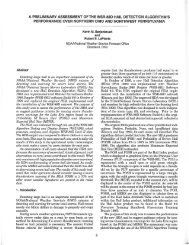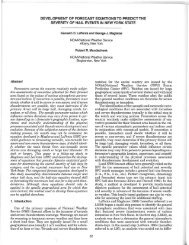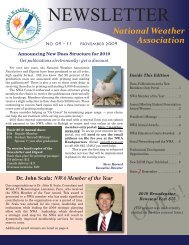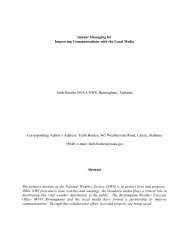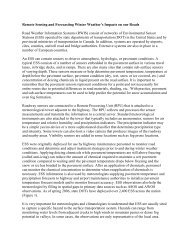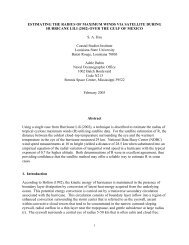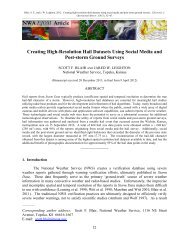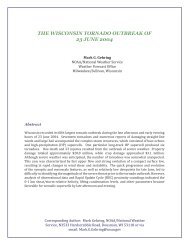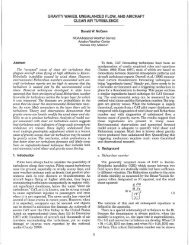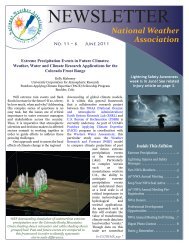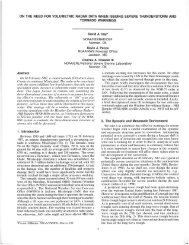A Program for Calculating the Montgomery Stream Function
A Program for Calculating the Montgomery Stream Function
A Program for Calculating the Montgomery Stream Function
Create successful ePaper yourself
Turn your PDF publications into a flip-book with our unique Google optimized e-Paper software.
Volume 20 Number 3 March, 1996<br />
55<br />
(4) Determine T from <strong>the</strong> average of To and Tb<br />
T = Tb + To<br />
2<br />
(19)<br />
(5) Substitute results from steps (1)-(4) into (17) to find M.<br />
These steps can be translated into common computer languages,<br />
or encoded as a macro in upper-air and gridded-data<br />
processing packages which allow <strong>the</strong> user to find <strong>the</strong> nearest<br />
isobaric sUlfaces above and below an isentropic suiface of<br />
interest. A simple FORTRAN program which computes M is<br />
shown in <strong>the</strong> Appendix. If <strong>the</strong> comments are removed, <strong>the</strong><br />
program is very short and easily typed with a text editor or<br />
word processor. The program assumes that <strong>the</strong> user has in<strong>for</strong>mation<br />
from isobaric surfaces above and below <strong>the</strong> isentropic<br />
surface of interest. In practice this in<strong>for</strong>mation would likely be<br />
contained in arrays so that <strong>the</strong> user would reference array elements<br />
instead of READ statements (or o<strong>the</strong>r language-specific<br />
input statements). Input isobaric data and M <strong>for</strong> two analyses<br />
along <strong>the</strong> 319.5 K isentropic surface are given in Tables 1<br />
and 2 in <strong>the</strong> Appendix. The data are taken from 3-h CLASS<br />
radiosonde observations at 2100 UTC 8 March 1992 - 0000<br />
UTC 9 March 1992 during STORM-FEST (STormscale Operational<br />
and Research Meteorology-Fronts Experiment Systems<br />
Test) (Cunning and Williams 1993). As part of STORM-FEST,<br />
flow along <strong>the</strong> 319.5 K isentropic surface was followed by<br />
an instrumented aircraft (Prater 1994) during lee cyclogenesis<br />
(Mahoney et al. 1995).<br />
3. Results<br />
Figure 1 shows M (thick lines), geostrophic wind isotachs<br />
(thin, dashed lines), pressure (thin, solid lines) and observed<br />
winds on <strong>the</strong> 319.5 K isentropic surface at 2100 UTC 8 March<br />
1992. M was computed using <strong>the</strong> first data set in <strong>the</strong> Appendix.<br />
M was contoured at a 1200 m 2 S - 2 interval to aid comparison<br />
with height on isobaric charts contoured at a 120 m interval.<br />
The figure shows a trough over <strong>the</strong> sou<strong>the</strong>rn Rockies and <strong>the</strong><br />
exit region of a jet. Observed wind speeds over sou<strong>the</strong>rn New<br />
Mexico and west Texas are sub-geostrophic, as expected in<br />
cyclonically-curved flow. In <strong>the</strong> operational environment, <strong>the</strong><br />
quality of an isentropic analysis is often assessed by comparing<br />
it with a nearby isobaric surface. That approach will be used<br />
here. Height, geostrophic wind isotachs and observed winds on<br />
<strong>the</strong> nearby 320-mb isobaric surface are shown <strong>for</strong> comparison in<br />
Fig. 2. Figures 1 and 2 show reasonable qualitative agreement<br />
between <strong>the</strong> pressure gradient fields and geostrophic wind<br />
speeds, with exception of southwest Texas where <strong>the</strong> 319.5 K<br />
isentropic surface was closer to 400 mb. Ano<strong>the</strong>r example of<br />
M on <strong>the</strong> 319.5 K isentropic surface from <strong>the</strong> program at 0000<br />
UTC 9 March 1992 (<strong>the</strong> second data set in <strong>the</strong> Appendix) is<br />
shown in Fig. 3. This analysis shows good time continuity with<br />
Fig. 1, with eastward motion of <strong>the</strong> trough and nor<strong>the</strong>astward<br />
propagation of <strong>the</strong> jet streak. Analysis of <strong>the</strong> nearby 320-mb<br />
8640 20----.<br />
320 mh<br />
2100 UTe<br />
08 March 1992<br />
Fig. 2. 320-mb isobaric analysis at 21 00 UTe 8 March . Height (thick<br />
lines and meters); observed winds (m s- ') (same barb convention<br />
as in Fig. 1); geostrophic wind isotachs (dashed lines and m s- ')<br />
319.5 K<br />
2100 UTe<br />
08 March 1992<br />
Fig. 1. The 319.5 K isentropic surface at 2100 UTe 8 March 1992.<br />
M computed from <strong>the</strong> program (thick lines and m 2 s -2); isobars (thin<br />
lines and mb); observed winds (m s- '); full barb = 10 m s- '; flag<br />
= 50 m s-'; geostrophic wind isotachs (dashed lines and m s- ').<br />
'-..40~<br />
319.5 K<br />
0000 UTe<br />
09 March 1992<br />
Fig. 3. Same as Fig. 1 except 0000 UTe 9 March 1992.



